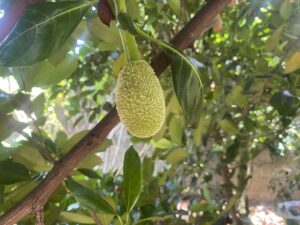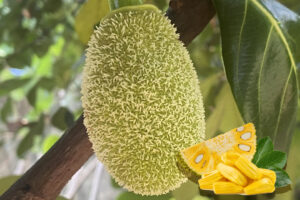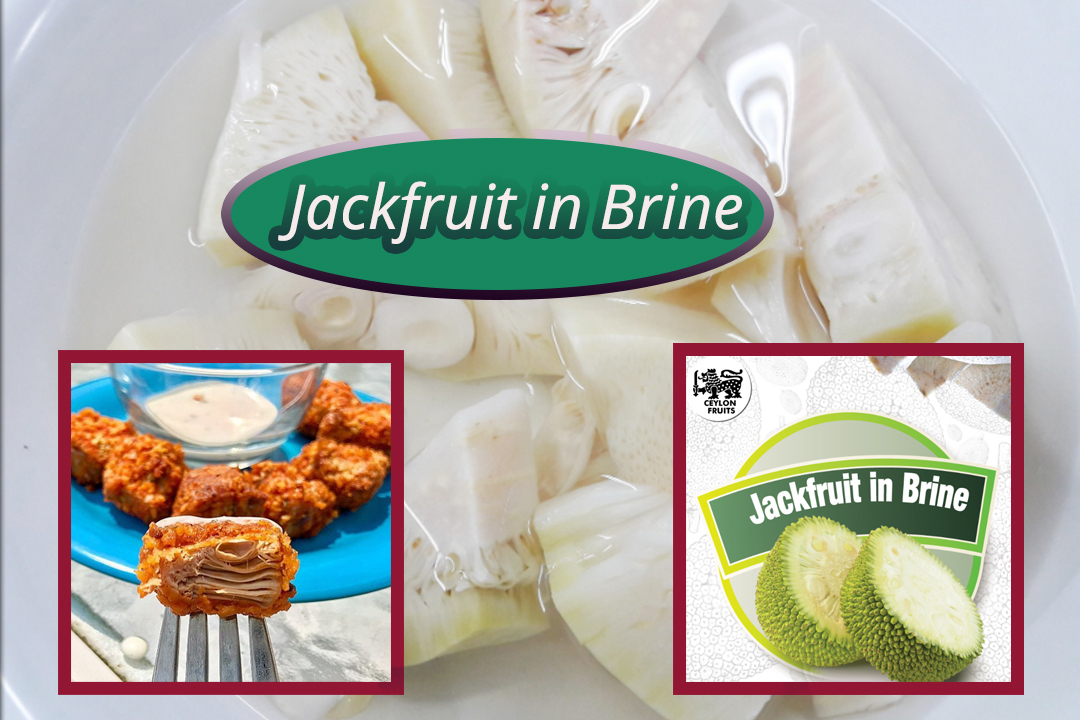Understanding Jackfruit in Brine: jackfruit canned in water

Jackfruit in brine is a form of preservation that transforms ripe jackfruit into a versatile ingredient with an extended shelf life. The process involves immersing the fruit in a water and salt solution, sometimes supplemented with citric acid or other preservatives. This brining method effectively inhibits the growth of microorganisms, preserving the fruit’s flavour and texture while imparting a savoury undertone.
The process of preparing jackfruit in brine typically begins with the selection of ripe jackfruit. The fruit is harvested when fully mature, as indicated by its yellowish-green exterior and aromatic scent. Once harvested, the jackfruit is carefully cleaned and prepared for preservation.
In facilities specialized in fruit preservation, the prepared jackfruit undergoes a brining process. This involves submerging the fruit in a solution containing water and salt. The salt concentration in the brine solution helps draw out moisture from the fruit, creating an environment that is inhospitable to bacteria and other spoilage organisms. Additionally, the salt acts as a flavour enhancer, contributing to the savoury taste of the preserved jackfruit.
Depending on the specific recipe or manufacturer’s preferences, citric acid or other preservatives may be added to the brine solution. Citric acid serves multiple purposes, including adjusting the solution’s acidity to inhibit microbial growth and enhancing the fruit’s natural flavour. Other preservatives may be used further to extend the shelf life of the preserved jackfruit, ensuring its quality and safety over an extended period.
Once the jackfruit is fully submerged in the brine solution, it is left to undergo the preservation process. Depending on the size of the fruit and the desired degree of preservation, the brining time can change. Typically, the jackfruit remains in the brine solution for several hours to allow sufficient time for the salt and other preservatives to penetrate the fruit and inhibit microbial activity.
After the brining process, the jackfruit is carefully removed from the brine solution and prepared for packaging. In commercial settings, the preserved jackfruit may undergo additional processing steps, such as rinsing to remove excess salt or packing into containers for distribution.
Overall, preparing jackfruit in brine involves meticulous attention to detail to ensure the quality and safety of the preserved fruit. From selecting ripe jackfruit to immersion in brine solution and subsequent packaging, each step plays a crucial role in protecting the fruit’s flavour and texture while extending its shelf life.
Nutritional Profile:

Jackfruit in brine is a versatile and flavorful ingredient and a nutritious addition to a balanced diet, particularly for those seeking to incorporate more plant-based foods into their meals. Despite being low in protein and fat, jackfruit in brine retains much of the nutritional value of fresh jackfruit, making it a valuable component of plant-based diets.
Importance of a Plant-Based Diet:
Health Benefits: Numerous health benefits of plant-based diets have been connected to them, a decreased chance of developing long-term illnesses like diabetes, heart disease, and several types of cancer. They are typically higher in dietary fibre, vitamins, and minerals while lower in saturated fats and cholesterol compared to diets rich in animal products.
Environmental Sustainability: Plant-based diets are more environmentally sustainable than diets high in animal products. Livestock farming requires significant land, water, and resources, contributing to deforestation, greenhouse gas emissions, and biodiversity loss. People may lessen their environmental impact and help create more sustainable food systems by shifting towards plant-based foods.
Ethical Considerations: Many people choose plant-based diets for moral reasons, including concerns about animal welfare and the treatment of animals in the food industry. People can support animal welfare by matching their food choices to their moral principles by opting for plant-based foods.
Other Plant-Based Foods as Meat Alternatives:
Legumes: Legumes such as beans, lentils, and chickpeas are excellent sources of protein, dietary fibre, vitamins, and minerals. They are helpful in various recipes, such as burgers, salads, stews, and soups, providing a satisfying and nutritious alternative to meat.
Tofu and Tempeh: Tofu and tempeh are soy-based products that serve as versatile meat substitutes. Tofu has a soft texture and can be used in stir-fries, curries, and sandwiches, while tempeh has a firmer texture and is often used in dishes like stir-fries, tacos, and salads.
Seitan: Seitan, also known as wheat gluten or wheat meat, is a protein-rich meat substitute made from wheat gluten. It has a chewy texture and can be flavoured and seasoned in various ways. Seitan is commonly used in stir-fries, kebabs, and sandwiches.
Plant-Based Meat Alternatives: There is a growing market for plant-based meat alternatives made from pea protein, soy protein, and mushrooms. These products mimic meat’s taste, texture, and appearance, making them suitable substitutes in dishes like burgers, sausages, and meatballs.
Nuts and Seeds: Nuts and seeds are nutrient-dense foods that provide protein, healthy fats, vitamins, and minerals. They can be incorporated into dishes such as salads, stir-fries, and grain bowls, adding texture and flavour while boosting the nutritional content of meals.
Incorporating various plant-based foods into one’s diet, including jackfruit in brine, legumes, tofu, tempeh, seitan, Nuts and seeds, can offer a variety of nutrients and lessen the need for animal products. With thoughtful preparation and inventiveness in the kitchen, plant-based diets can be delicious, nutritious, and environmentally sustainable alternatives to traditional meat-centred diets.
Culinary Uses:
The culinary uses of jackfruit in brine are diverse and expansive, making it a sought-after ingredient in various cuisines worldwide. Here are some popular applications of jackfruit in brine:
Meat Substitute in Vegetarian and Vegan Dishes:
Jackfruit in brine is prized for its fibrous texture, resembling pulled pork or shredded chicken. This makes it an ideal choice for creating plant-based versions of dishes like tacos, hamburgers and sandwiches. Because of its bland flavour, it can take on the flavours of marinades and seasonings, making it a versatile and satisfying alternative to meat.
Asian Cuisine:
Jackfruit in brine is a staple ingredient in many Asian cuisines, where it is used in various savoury dishes. Jackfruit adds a unique texture to curries and absorbs the rich flavours of spices and sauces. It is also commonly used in stir-fries, where its tender yet meaty consistency pairs well with vegetables and aromatic sauces. Additionally, jackfruit in brine is a popular addition to soups, imparting a subtle sweetness and enhancing the overall depth of flavour.
Versatile Addition to Savory and Sweet Dishes:
One of the critical attributes of jackfruit in brine is its ability to absorb flavours, making it a versatile addition to both savoury and sweet dishes. It is suitable for sauces, marinades, and dressings in savoury preparations to impart a unique tropical twist. On the sweeter side, jackfruit in brine can be incorporated into desserts like ice cream, cakes, and puddings, adding a subtle sweetness and hint of tropical flavour.
Overall, jackfruit in brine offers a wide range of culinary possibilities, from savoury meat substitutes to flavorful additions to both savoury and sweet dishes. Its unique texture, ability to absorb flavours, and neutral taste make it a beloved ingredient in vegetarian and vegan cooking and traditional Asian cuisine. Whether used as a meat alternative or a flavorful addition to various dishes, jackfruit in brine inspires creativity in the kitchen and delights taste buds worldwide.
Health Benefits:
Jackfruit in brine boasts a plethora of health benefits beyond its culinary versatility. Here’s a closer look at how this tropical fruit can contribute to overall well-being:
High Fiber Content for Digestive Health:
Jackfruit in brine is rich in dietary fibre, vital for maintaining intestinal health. Constipation can be avoided, regular bowel movements are encouraged, and intestinal health is preserved with the help of fibre. Additionally, dietary fibre can help regulate blood sugar and lower cholesterol levels, lowering the chance of developing long-term conditions, including diabetes and heart disease.
Promotes Feelings of Fullness and Weight Management:
The high fibre content in Brined jackfruit also adds to a sense of fullness and satisfaction. By promoting a sense of satisfaction after meals, jackfruit in brine can help individuals control their appetite and lower total calorie consumption, which could aid in weight loss attempts.
Rich in Essential Vitamins:
Jackfruit in brine is a rich source of essential vitamins, including vitamins A, C, and various B vitamins. It takes vitamin A to keep your vision healthy, support immune function, and promote skin well-being. Antioxidant vitamin C prevents cell damage and boosts collagen synthesis for healthy skin and the immune system. B vitamins, such as thiamine, riboflavin, and niacin, play essential roles in synthesizing red blood cells, the neurological system, and energy metabolism.
Mineral-Rich Composition:
In addition to vitamins, jackfruit in brine is abundant in essential minerals, including potassium and magnesium. Potassium is vital for maintaining fluid balance, regulating blood pressure, and supporting heart health. There are more than 300 enzymatic reactions using magnesium that support bone health, energy production, and the health of muscles and nerves in the body.
Incorporating jackfruit in brine into numerous health advantages can be obtained from your diet, including supporting intestinal health and weight management to provide essential vitamins and minerals for overall well-being. Its nutrient-rich profile makes it valuable for a balanced and healthy diet.
